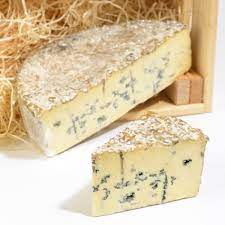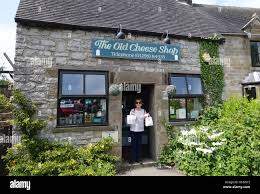What Is Blue Vein Cheese?
Blue cheese is a generic term used to describe cheese produced with pasteurized cow’s, sheep’s, or goat’s milk and ripened with cultures of the mold penicillium. Blue cheese generally has a salty, sharp flavor and a pungent aroma. It is often relatively low in fat but has a high sodium content. Blue cheese is a good source of protein, calcium, and phosphorous.
VOCABULARY: generic, vein, ripened, mold, cultures, sharp flavour, aroma, low in fat, source
Facts
• Source: Cow’s, sheep’s, and goat’s milk
• Origin: England, France and Italy
• Flavor: Traditionally sharp and salty with variations
• Rind: Edible
OUR LOCAL CHEESE SHOP
https://www.hartingtoncheeseshop.co.uk
Blue cheese is thought to have been invented by accident when cheese was stored in temperature- and moisture-controlled caves during the Middle Ages. It’s believed that at one point a half-eaten loaf of bread was left behind in a cave by a cheesemaker in Roquefort, France, and, upon his return, he discovered that the mold covering the bread had transformed the cheese into blue cheese.
VOCABULARY: invented, stored, moisture, middle ages, loaf of bread, transformed
How Blue Vein Cheese Is Made
Raw milk is pasteurized and then acidification occurs when a starter culture is added to convert lactose to lactic acid, changing the milk from liquid to solid. Rennet is added to help coagulate the milk, and the curds are cut to release the whey. The curds are drained and formed into wheels. At this stage, Penicillium roqueforti is sprinkled over the cheese, and the cheese is salted to prevent spoilage. The cheese is left to age for 60 to 90 days. The cheese’s signature blue veins are created during the early aging stage when the cheese is “spiked” with stainless steel rods to let oxygen circulate and encourage the growth of the mold. This is also referred to as “needling.” This process softens the texture and develops the cheese’s distinctive blue flavour.
VOCABULARY: Raw milk, acidification, coagulate, drained, wheels, sprinkled, spoilage, signature, stage, spiked, steel rods

While the mold cultures and needling contribute largely to the flavor and texture of blue cheese, other factors are always at play. The type of milk that is used (cow’s, sheep’s, or goat’s), what the animals were eating before they were milked, and the slightly different cheesemaking techniques used by each cheesemaker ensure that every blue cheese around the world will have its own distinct flavor.
VOCABULARY: needling, texture, always at play, goat, milked, ensure,
Types of Blue Vein Cheese
Roquefort is considered one of the oldest blue cheeses, and it’s also considered a delicacy. Produced from sheep’s milk and aged in the limestone cliffs in the south of France, Roquefort is recognized for the blue veins stretching across its moist and crumbly body. It’s delightfully nuanced, both creamy and aromatic, complex and intense, with sharp and sweet flavor notes.
Gorgonzola is an Italian cheese produced from milk from cows that graze in the pastures of Lombardy and Piedmont. Young Gorgonzola is soft, buttery, and creamy with tiny hints of sharp blue. Aged versions are earthier, with a stronger flavor and more piquant bite.
VOCABULARY: considered, delicacy, limestone, cliffs, stretching, moist, crumbly, delightfully, nuanced, aromatic, sharp, sweet
This is our local real cheese shop.

Blue Stilton is a cow’s milk cheese produced in the English midlands. It’s a sturdy cylindrically formed cheese, beautifully marbled with streaks of blue. It has a slightly moist and crumbly texture with a rich, creamy, nutty, and salty flavor.
Danablu is a Danish cow’s milk blue cheese produced on the island of Funen. It has a creamy and smooth texture and a slightly sharp and salty flavor, which is similar to Roquefort but milder.
VOCABULARY: Blue stilton, Midlands, study, cylindrical, formed, marbled, streaks of blue, nutty, smooth, creamy, texture
Double-cream blue cheese is a category unto itself, with a later arrival on the blue cheese timeline in the late 20th century. Distinguished by a creamy interior and sometimes a bloomy rind, it’s made from cow’s milk enriched with cream. Examples of this cheese are Cambozola, Saint-Agur, and Blue Castello.
VOCABULARY: double cream, unto itself, later arrival, timeline, distinguished, bloomy rind, enriched
Substitutes
With so many variations of blue cheese, one can often be substituted for another. Be sure to choose cheeses of similar textures and flavor profiles, such as Roquefort and Danablu; or a young Gorgonzola and Blue Castello; or Cambozola and Saint-Agur.
VOCABULARY: variations, substituted, profiles
Uses
Blue cheese pairs exceptionally well with fruit and nuts, and it’s an excellent addition to an assorted cheese board. Whisk it into creamy sauces, dressings, and soups as a flavor enhancer or sprinkle it over salads. It also provides an umami kick of flavor to meat stuffings, cheesy pasta dishes, and baked grains.
VOCABULARY: pairs, cheese board, whisk, creamy sauces, flavour enhancer, sprinkle, umami kick, meat stuffings, baked grains
Storage
Store opened blue cheese, wrapped in foil or parchment or waxed paper, in the refrigerator for up to three weeks. Blue cheese can also be wrapped and frozen in an airtight container or a zip-close bag for up to three months and defrosted in the refrigerator. The texture of frozen blue cheese will become more crumbly, and the flavor will diminish slightly, so it’s best to use thawed blue cheese in cooked dishes.
VOCABULARY: wrapped in foil, waxed paper, airtight, zip-closed bag, defrosted, diminish, slightly, thawed
WRITING EXERCISE: 100 words.
Research a delicious recipe that uses blue vien cheese and desride it in 100 words using as many adjectives as you can think of.
